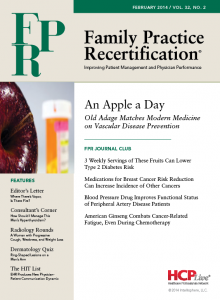Blood Pressure Drug Improves Functional Status of Peripheral Artery Disease Patients
Among patients with peripheral artery disease and intermittent claudication, a daily dose of 10 mg ramipril can improve pain-free treadmill walking times, which are associated with a significant increase in physical functioning.
Frank J. Domino, MD
Review
Ahimastos AA, et al. Effect of ramipril on walking times and quality of life among patients with peripheral artery disease and intermittent claudication: a randomized controlled trial. JAMA 2013 Feb 6; 309(5):453-60. http://jama.jamanetwork.com/article.aspx?articleid=1568251.
Study Methods
In this trial, 106 patients with stable peripheral artery disease (PAD) were randomized to a daily dose of 10 mg ramipril, while another 106 were randomized to placebo. All of the study subjects received usual care for their risk profiles and symptoms, including lipid-lowering therapy, antiplatelet therapy, and blood pressure control.
In order to be enrolled in the study, participants were required to have an ankle brachial index (ABI) of <0.90 at rest in at least 1 leg, which is the common objective definition of PAD. All evaluated subjects also had a history of intermittent claudication and a stable medication regimen that did not include an angiotensin-converting enzyme (ACE) inhibitor, angiotensin II receptor blocker (ARB), potassium-sparing diuretic, or potassium supplement for the 6 preceding months.
The subjects’ baseline characteristics were similar, and roughly 30% of the placebo group and 39% of the ramipril group were smokers, which was a non-significant difference.
All participants underwent a treadmill test at baseline and the 6-month mark. In addition to the treadmill tests, subjects were evaluated using ankle-brachial index (ABI) measurements and ultrasound duplex scanning. Patient-reported symptoms and functional status were assessed by the Walking Impairment Questionnaire (WIQ), and health-related quality of life (QOL) was determined by the Survey Short Form 36 (SF-36), divided into a physical and mental component.
Results and Outcomes
Of the 212 participants initially randomized to ramipril or placebo, 200 completed the 6-month follow-up survey; the other 12 experienced adverse medication events, persistent cough, or a loss of interest that impeded completion. Patient medication compliance calculated via pill count was found to be 100%.
Based on treadmill testing, ramipril was associated with a 75-second increase in mean pain-free walking time (P< 0.001) and a 225-second increase in maximal walking time (P< 0.001). Though blood pressure was slightly reduced in the ramipril group compared to the placebo group, the improvements in walking time were found to be independent of the ramipril arm’s change in blood pressure.
There was a small increase in ABI at rest and after exercise in the ramipril group. Duplex ultrasonagraphy found a subset of patients with femoropopliteal disease had improved blood flow proximal to their stenotic site, but there was no change in stenosis itself in the ramipril group compared to the placebo group.
Concerning the QOL questionnaires, the WIQ showed the ramipril arm was associated with score improvements. Specifically, the median distance, speed, and stair climbing scores all favored ramipril and were statistically significant compared to placebo.
Though the SF-36 demonstrated an overall significant improvement in the ramipril group compared to the placebo group, there was no significant difference between the 2 groups on the survey’s mental component.
Conclusion
Among patients with PAD and intermittent claudication, a daily dose of 10 mg ramipril improved pain-free and maximal treadmill walking times, which were associated with a significant increase in physical functioning determined by the SF-36 survey.
Commentary
The incidence of PAD in the US and Europe is currently estimated at approximately 27 million patients. Smoking cessation, in particular, produces the greatest clinical benefit in both patient symptoms and vascular outcomes, while current PAD drug treatments like pentoxifylline and cilostazol have a limited impact on functional status.
However, previous studies suggested ramipril might improve pain-free and maximum treadmill walking times, which served as the inspiration for this study that found such benefits from a 10 mg dose in patients with multiple vascular risk factors.
Based on WIQ scores, patient-reported functional status improved among those treated with ramipril compared to placebo, which was especially apparent in the ramipril arm’s ability to perform activities of daily living. Coupled with improvements in the physical health component of the SF-36, this demonstrates ramipril produces significant patient-observed benefits. However, it is unclear whether smoking cessation or a scheduled exercise program would deliver additional benefit to ramipril therapy.
The study authors suggested a number of mechanisms of action for ramipril in PAD, including increased peripheral blood flow, adaption of skeletal muscle, vasodilatation through reduction of angiotensin II, sympathetic inhibition, and improved endothelia function. Regardless of the drug’s physiologic mechanism, this is a significant and simple intervention for patients with PAD and intermittent claudication. Nevertheless, it remains to be seen whether the benefit lasts beyond the study’s 6-month limit or becomes less effective in the presence of severe comorbidities that were not listed in the trial’s exclusion criteria.
Until then, it seems prudent to consider offering ramipril to PAD patients with the requisite follow-up evaluation of blood chemistries and renal function, as well as a reminder to limit use of non-steroidal anti-inflammatory drugs (NSAIDs). Family physicians should also query about the patients’ interest in smoking cessation at each office visit, since no intervention has been found to improve PAD symptoms and clinical outcomes more than that one lifestyle modification.
About the Author
Frank J. Domino, MD, is Professor and Pre-Doctoral Education Director for the Department of Family Medicine and Community Health at the University of Massachusetts Medical School in Worcester, MA. Domino is Editor-in-Chief of the 5-Minute Clinical Consult series (Lippincott Williams & Wilkins). Additionally, he is Co-Author and Editor of the Epocrates LAB database, and author and editor to the MedPearls smartphone app. He presents nationally for the American Academy of Family Medicine and serves as the Family Physician Representative to the Harvard Medical School’s Continuing Education Committee.
